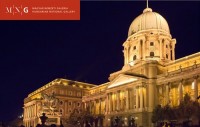Mihály Munkácsy, after settling down in Paris in 1872, upon the call of his friend and fellow artist László Paál, travelled to the village of Barbizon in the Fontainebleau forest in 1873. Barbizon was made famous in the early 19th century by a group of French artists who favored painting outdoors. In the pictures of Millet, Courbet, Daubigny and Dupré everyday scenes – people working, strolling, travelling – appear in a natural setting. The manner of painting also changed: the all-devouring gallery tone gave way to light-imbued colours and their tones to suggest atmospheric effects, the vibration of the air, the motion of light and shade. Woman Carrying Brushwood is an example of this fresh approach. It shows a woman by a trail in the forest, resting from picking and carrying brushwood. The depiction of work-weary people without any beautifying is typical of realism, a style that can also be related to Barbizon. Munkácsy’s painting is slightly melancholic, though the tired face, the stooped body and the rendering of the hand are tools of a representation devoid of idealization.
en

